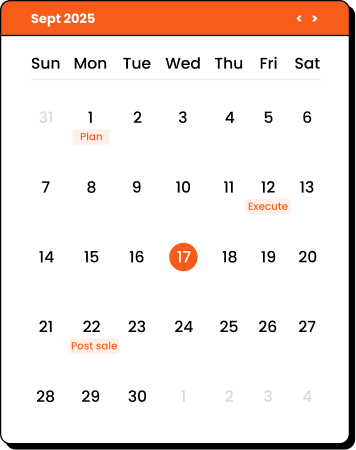With ecommerce email campaigns, you get a direct line to your customers.
The return on email marketing is very high. As of 2025, email marketing offers an average ROI of $36 for every $1 spent (a 3600% return), outperforming most digital channels. Thus, it’s one of the most cost-effective marketing tools out there.
But, sending email campaigns that convert is the real battle.
Low open rate? Complexity of sending personalized email marketing campaigns? Designing the layout? The hurdles are many.
Over 4.5 billion people use email worldwide in 2025; this number will surpass 4.8 billion by 2027, making email the most widely used digital channel. So, you cannot ignore this means of reaching customers.
Thus, in this blog, we help you master email marketing by explaining everything you need to know from types, email marketing examples, startegies and know how to create and automate your campaign.
Send automated email campaigns with Retainful’s easy-to-setup email automation. Automate in 3 clicks, not 3 pages.
What is an Email Campaign?
An email campaign involves sending one email or a series of emails to an audience to promote offers, nurture leads, or recover abandoned carts.
Emails are sent using email automation tools based on customer behavior or specific timeframes.
Here is an example of a welcome email drip campaign.
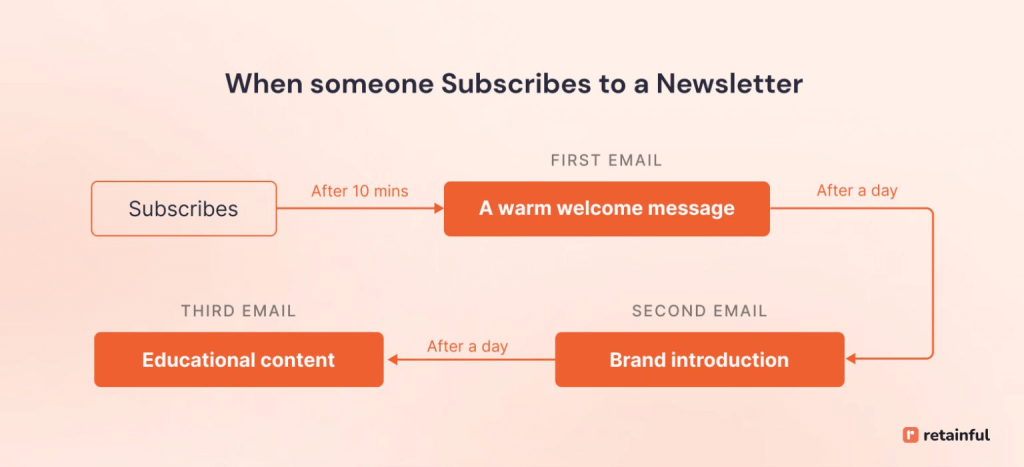
Types of Ecommerce Email Marketing Campaigns (And When to Send Them)
The different types of email marketing campaigns are:
- Awareness Stage: Welcome & Nurture New Shoppers
- Welcome Email Series
- Newsletter Emails
- Consideration Stage: Build Trust with Helpful Content
- Survey & Feedback Emails
- Educational / Content-Focused Newsletters (if you want, can sit here too)
- Decision Stage: Convert Hesitant Buyers into Customers
- Transactional Emails (Order Confirmations, Shipping Updates → add reassurance)
- Abandoned Cart Recovery Email Campaign
- Promotional and Discount Emails
- Product Launch Emails
- Loyalty Stage: Keep Customers Coming Back for More
- Upsell & Cross-Sell Emails
- Seasonal & Holiday Campaigns
- Re-engagement email campaign for ecommerce Emails
- Advocacy Stage: Turn Loyal Customers into Brand Promoters
- Referral Program Emails
- Survey & Feedback Emails (when used for testimonials/reviews)
You can send different types of ecommerce campaigns based on the customer’s position in the email marketing funnel. Some have just subscribed and some already have been your repeat customer.
The best email marketing strategy is to not send the same email to every customer. For example, a new customer isn’t ready to refer someone or join a loyalty program, so sending them a referral program email would be shooting bullets in the dark.
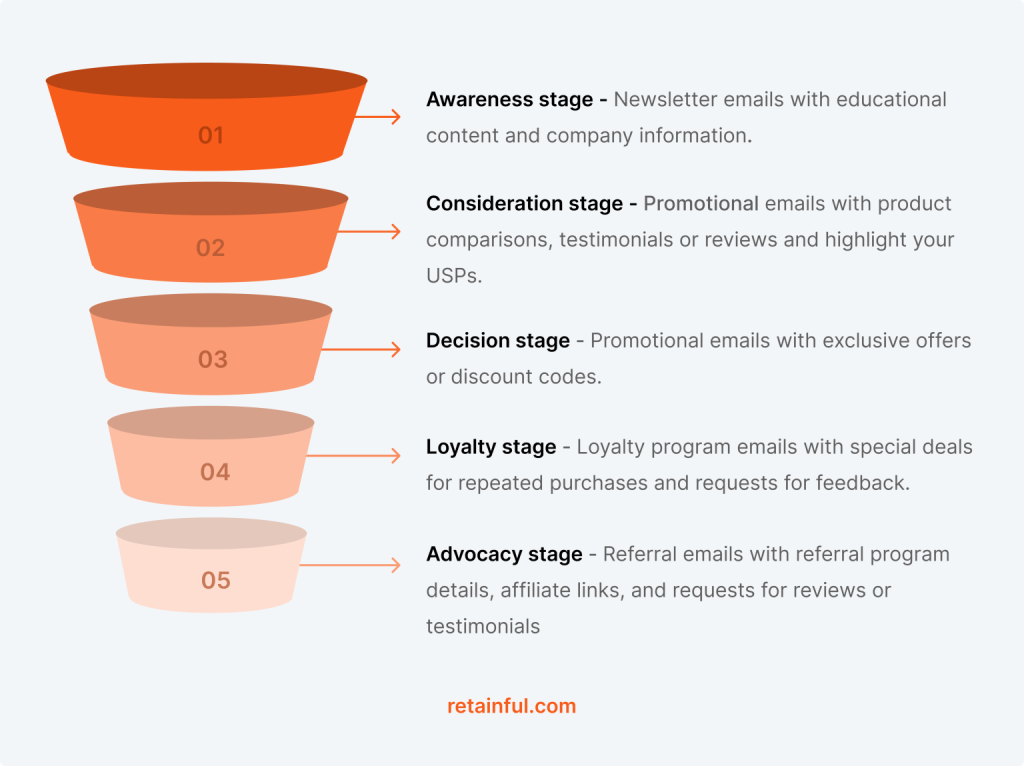
Here are the types of email campaigns for online stores to send at each stage of the customer journey.
Awareness Stage: Welcome & Nurture New Shoppers
The top-of-the-funnel email marketing you can send are a welcome email or a nurturing email.
Consideration Stage: Build Trust with Helpful Content
The types of drip campaigns to send in this stage are newsletters or case studies.
Decision Stage: Convert Hesitant Buyers into Customers
The types of marketing campaigns you can send at this stage are limited-time offers, abandoned cart emails, and product comparisons with competitors.
Loyalty Stage: Keep Customers Coming Back for More
You can send thank you emails, loyalty program emails, and VIP offer emails.
Advocacy Stage: Turn Loyal Customers into Brand Promoters
At the advocacy stage, you can send referral emails and review request emails.
Start BFCM prep today, not November.
9 Best Ecommerce Email Campaign Examples (Proven to Drive Sales)
The 9 best ecommerce email campaign examples that are proven to drive sales are:
- Welcome Series Email – First Impressions That Sell
- Lead Nurturing Campaign – Educate & Build Credibility
- Abandoned Cart Emails – Recover Lost Sales Instantly
- Post-Purchase Emails – Thank Customers & Encourage Repeat Buys
- Feedback Request Emails – Collect Reviews That Build Trust
- Product Launch Emails – Create Hype and Drive Preorders
- Upsell & Cross-Sell Campaigns – Boost AOV Without Pressure
- Seasonal Sale Emails – Maximize Holiday Revenue
- Re-Engagement Emails – Win Back Dormant Customers
1. Welcome Series Email – First Impressions That Sell
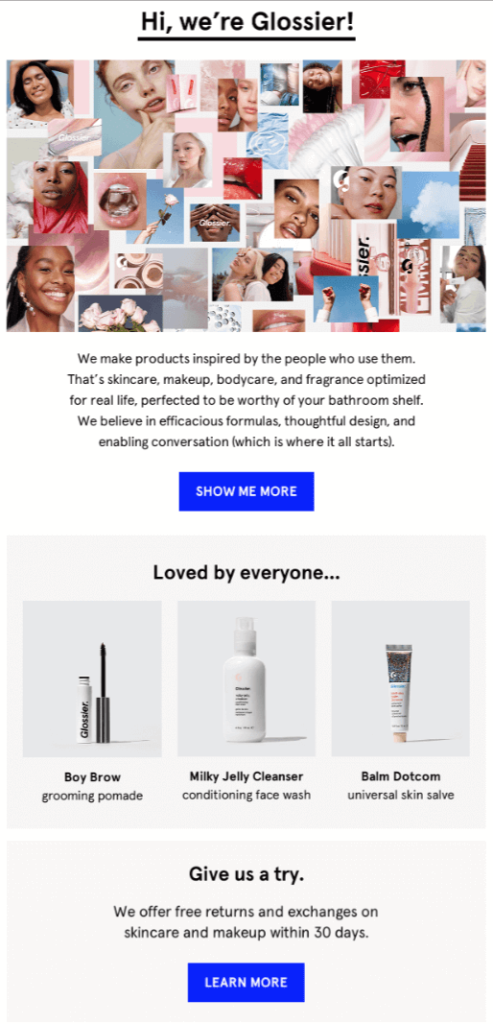
First, in this welcome email marketing camapign example, the short, casual tone makes the brand feel like a friend rather than a corporation, which is the perfect email marketing strategy for a beauty and skincare brand.
Welcome series email campaign is where you explain where your brand stands for. Glossier does it by writing about values and not being overly promotional.
Also, the CTAs in this email example- “Show me more and ‘Learn more” also don’t pressurize the readers to purchase immediately.
What to include in your welcome drip campaign:
- Showcase your top-sellers
- Handle objections and gain trust
- Convey what your brand stand for
- Don’t prompt the customer to purchase
2. Lead Nurturing Campaign – Educate & Build Credibility

The headline of this email template piques curiosity and makes readers think, “If it works for them, maybe it’ll work for me.”
Also, Typeform shows us how to build credibility like a pro – showing case studies as social proof. This email marketing strategy is perfect for prompting the customer to use the product without being too salesy.
In this campaign for lead generation, each section smoothly transitions to the next, building momentum from the introductory headline to the inspiring case studies to the final CTA.
The CTA “Create a new form” is clear, actionable, and positioned at the end of the marketing email template when the reader is most likely primed to take action.
What to include in your lead nurturing email?
- Include case studies
- Use inspiration-driven language rather than promotional tone
3. Abandoned Cart Emails – Recover Lost Sales Instantly

Overall, this abandoned cart email campaign example shows the product the recipient already checked out. It reinforces their interest and subtly encourages them to reconsider.
After showing the product they browsed, this ecommerce email campaign example smartly suggests complementary or similar products. Rael offers more reasons to click and shop.
More choices = more reasons to re-engage.
Also, the tags at the bottom of this marketing email template reinforce the brand’s values, building trust and making the reader feel good about purchasing.
This email drip campaign example smartly closes with additional ways to engage with the brand. So that even if the recipient doesn’t buy right away, they can subscribe or refer a friend.
So, what to include in your abandoned cart email:
- Visual reminder of browsed products
- Showcase related products
- Trust building elements to handle objections about making a purchase.
4. Post-Purchase Emails – Thank Customers & Encourage Repeat Buys

Homes Alive Pets nails this post-purchase email marketing campaign. It combines gratitude, support, and trust-building into a clear, visually appealing email template.
The purchase summary is clear and simple, reminding the customer exactly what they bought.
Also, by clearly showing they offer returns and nationwide shipping, this effective email example is reducing friction and making future purchases more likely.
This ecommerce email example goes a step further, offering support information if the customer has any questions. This makes the company feel approachable and willing to help, reducing any post-purchase anxiety.
What to include in your post-purchase email drip?
- Warm, personalized thank you.
- Reinforce the brand they chose is good
- Clear purchase summary
5. Feedback Request Emails – Collect Reviews That Build Trust

After a purchase, customers are already in the post-purchase glow. Also, they’re more likely to refer friends when they’re excited about the product. The best email marketing campaign strategy is to capitalize on this positive sentiment and ask for a review.
In this email example, they’ve taken something as simple as a review request and made it fun. For example, “Write stuff” is a clever play on words.
The CTA of this email campaign template is super clear – no fluff, no distractions. Sundays knows exactly what they want: a review. The button is bold, inviting, and leaves no room for ambiguity.
Particularly, in this feedback-request email campaign example, they’ve also framed the referral program as a win-win.
What to include in your email marketing:
- Don’t just ask, “What did you like?”, ask, “What can we improve?”
- Images that reinforce the brand identity
- Playful, on-brand language
Send both pre and post-purchase email campaigns with Retainful and drive repeat sales.
6. Product Launch Emails – Create Hype and Drive Preorders

The preorder CTA button is right under the hero image – exactly where it needs to be. Especially they don’t wait for you to scroll down through paragraphs of text before hitting you with the action step.
This marketing email campaign template includes just the right amount of features to build curiosity, but it’s not overwhelming. They pick the key selling points. No clutter, just the essentials.
Words like “masterfully” create the sense that Sonos has spent years honing these headphones. As a result It makes it sound like it’s not just another launch.
What to include in your email marketing campaign template:
- Same and multiple CTAs (avoids confusion)
- Feature breakdown
7. Upsell & Cross-Sell Campaigns – Boost AOV Without Pressure
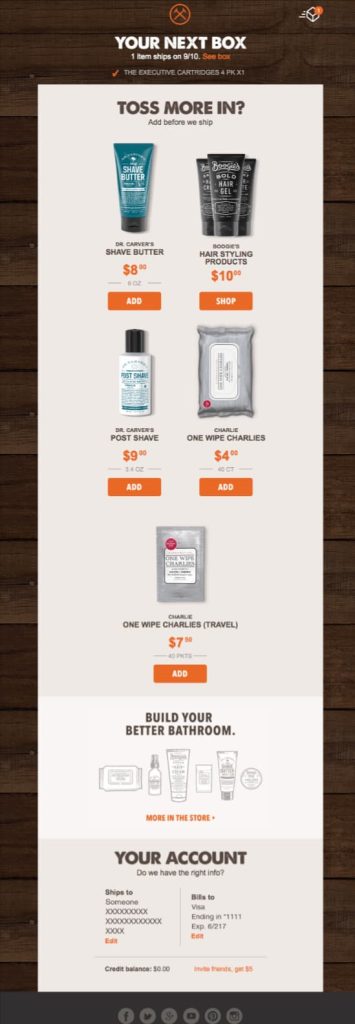
Altogether, this cross-sell email marketing example creates a natural lead-in for the upsell – since the order’s already being processed, tossing in something extra feels like no big deal.
It feels like a friendly suggestion from a buddy rather than a hard sell.
This email marketing campaign example has a curated selection of products customers can add with one click. No overwhelming you with 20+ options. Just 4-5 products that complement what you’re already getting.
Also, by reminding customers to double-check their shipping and billing info, this marketing email template subtly reduce friction for future purchases. It makes customers feel secure about their order.
Should you include upsell/cross-sell in your order confirmation emails?
Since the purchase decision has already been made, customers are in a spending mindset. A subtle upsell at this moment can nudge them into adding another item, boosting your average order value without feeling forced.
What to include in your email marketing template:
- Include only the products related to the main product
- State how much the discount is if purchased together
8. Seasonal Sale Emails – Maximize Holiday Revenue

Black Friday is THE event of the year for both shoppers and retailers. Sending a Black Friday email as part of a seasonal email marketing is a must in e-commerce email marketing.
Also, the main offer is communicated clearly, with the terms of the discount – “VALID THROUGH NOV 26 & ONE-TIME USE ONLY” – being immediately visible.
The Black Friday email campaign example clearly states the promo code “BLACKFRIDAY” to be used at checkout. By placing the code directly below the main offer, it reduces any potential friction for customers who want to take advantage of the deal.
What to include in your seasonal email?
- Segmented products into best sellers and newly launched
- Easy-to-find promo code
- Clear communication of the main offer
9. Re-Engagement Emails – Win Back Dormant Customers

Most customers lapse when they feel the product or service no longer meets their evolving needs or expectations.
Also, even if they have lapsed, their pain point remains the same. Through re-engagement email campaigns, reiterating the benefits of your product reminds customers how you can still help them solve their pain points.
This best win-back customer email example uses concise and straightforward messaging like “We’ve leveled up – Come see what’s new!” to pique the user’s interest and convey the improvements without being too wordy.
What should you include in your email marketing:
- Addressed the objection of lack of new products or improvement.
- Catchy tagline
- Included benefits of rejoining
How to Create and Automate Email Campaign (Step by Step)
The steps to create an email marketing campaign are:
- Define Your Goal – Every Campaign Starts with a Purpose
- Automate Smartly – Save Time with Ready Workflows
- Segment Your Audience – Send the Right Message to the Right Shopper
- Write Copy & Design Templates – Emails People Actually Read
- Plan Follow-Ups – Nudge Until They Convert
- Track Performance – Improve Every Campaign with Data
Step 1: Define Your Goal – Every Campaign Starts with a Purpose
Before you even think about writing email copy, ask yourself: What’s the point?
- Are you trying to increase sales?
- Maybe it’s about building trust with your audience.
- Or perhaps you just want people to read your blog post.
The first step in making an email campaign is to have one clear goal. You can’t do everything in one drip campaign. Keep it focused. Define your key goal upfront.
Before you even think about writing the email, ask yourself: What’s the point?
- Are you trying to increase sales?
- Maybe it’s about building trust with your audience.
- Or perhaps you just want people to read your blog post.
The first step in developing an campaign is to have one clear goal. You can’t do everything in one email drip strategy. Keep it focused. Define your key goal upfront.
Step 2: Automate Smartly – Save Time with Ready Workflows
You can use email automation to send an email campaign sequence automatically at well-timed intervals.
To do this you need to choose an email marketing software that has easy-to-setup automation to take the pressure off you in setting up automation workflows.
Here is what an email marketing campaign workflow looks like:
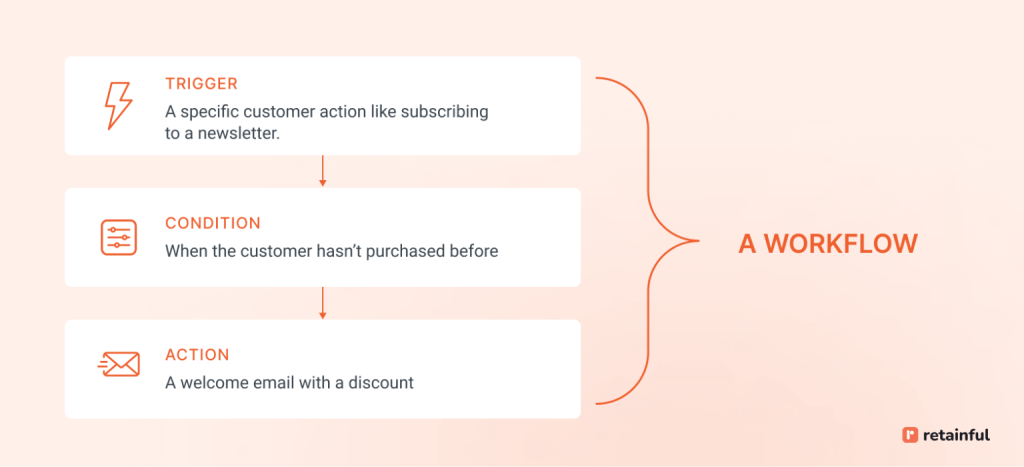
So, here is how to set up an email marketing:
- Choose the customer action to trigger the automated email campaign. Example: Sign up for the newsletter or a purchase.
- Choose which segment of your audience should receive it
- Set up the email sequence and the time delay between them.
Step 3: Segment Your Audience – Send the Right Message to the Right Shopper
Here’s where most email marketers mess up – they blast emails to everyone. But not everyone cares about the same thing. The key to send high-converting email? Segmenting your customers.
- Have they purchased from you before? Send them product updates.
- Are they new subscribers? Give them a warm welcome.
Segmented emails have the potential to have a 760% increase in revenue.
So, use data to group people based on their behavior, purchase history, email engagement metrics and where they are in your funnel and use this to personalize your email campaigns.
Sending the right message to the right people is half the battle. The other half? Let’s get to that.
Step 4: Write Copy & Design Templates – Emails People Actually Read
While writing your email campaign copy, focus on benefits, not features.
- Feature: “Our jacket is waterproof.”
- Benefit: “Stay dry, even in the wildest rainstorms.”
Your marketing email campaign CTA should be simple and unmissable. Use buttons like “Get Your Discount” or “Claim Offer”. Avoid weak phrases like “Click Here.” Keep the CTA above the fold and make it pop with color.
Tip: Don’t be afraid to repeat CTA at the bottom for those who read to the end.
So, once they’ve clicked, you have seconds to keep them hooked with yout tagline.
Boring: “Thanks for subscribing to our newsletter.”
Better: “We’ve got something special for you today…”
Step 5: Plan Follow-Ups – Nudge Until They Convert
A one-off email campaign is rarely enough. Most people don’t act on the first email they receive.
The email campaign best practice is to send follow-up emails based on the engagement rate of the previous email.
A great email marketing campaign adjusts the follow-up sequence based on recipient behavior.
- If they opened but didn’t click: Send a follow-up highlighting key benefits.
- If they clicked but didn’t convert: Show testimonials or answer objections.
- If they didn’t open: Try a different subject line or send at another time.
Step 6: Track Performance – Improve Every Campaign with Data
It doesn’t end after you hit send. You need to track how your email campaigns performed.
Here are some email marketing campaign metrics to track:
- The average open rate for email campaigns is 26.6% as of 2025 email marketing industry benchmarks. Thus, anything above 20% is strong (e-commerce average is about 30%).
- A good click-through rate (CTR) typically falls between 2% to 5%, with higher rates seen in niche and segmented lists.
- Click-to-open rate (CTOR), which reflects the percentage of opened emails that received clicks on links inside, remains a critical engagement indicator.
- The deliverability rate should be above 95% for optimal performance; rates below 95% indicate list or sender issues.
- The average conversion rate for email campaigns is 2.8% (B2C) and 2.4% (B2B).
To measure the success of an email campaign, use this data to optimize future campaigns.
Automated emails produce 320% more revenue, but they are never a one-and-done thing. Hence, you should constantly be learning, tweaking, and improving.
Best Practices for High-Converting Ecommerce Email Campaign
1. Write Subject Lines That Get Opened
If your subject lines for email flop, your email campaign is dead on arrival.
Here are some email marketing tips for writing great subject lines for ecommerce email campaigns:
- Use curiosity, urgency, or personalization.
- Test emojis.
- Avoid spam triggers like “Free!! “
Great email marketing campaigns start with great subject lines. If you can’t hook in under 5 seconds, you’ve lost them.
2. Focus on One Goal per Email
The more choices you give in your email marketing campaign, the fewer actions people take.
So the email marketing campaign best practice is to focus on one goal per email campaign.
Here are email marketing campaign tips to increase conversion:
- One email = One action.
- Selling something? Focus on that.
- Announcing a launch? Keep it about the launch.
- Sharing content? Highlight one key takeaway.
Email campaign marketing works best when the reader knows exactly what to do next.
3. Design Email Campaigns for Easy Skimming
In general, nobody reads emails word for word. They scan.
A great email marketing campaign must be visually structured for quick consumption.
Here’s how to design an email marketing campaign:
- Keep paragraphs short. Break your content into bite-sized sections.
- Add whitespace for breathing room. Add spacing between paragraphs.
- Use a visual hierarchy. Your email should guide the reader’s eyes naturally from one section to the next. Headline -> Image -> CTA.
4. Make CTAs Unmissable So They Get Clicked
Your CTA is the most important part of the email campaign design. If it blends in, you’re losing conversions.
Here are the email campaign best practices for designing CTA:
- Use contrasting colors so the button stands out.
- Keep CTA text short & actionable
- No distractions near the CTA – give it space.
A best email campaign design makes clicking CTA effortless and obvious.
5. Personalize Beyond First Name To Resonate Bettersonalize
The email campaign best practice is to not just add a name at the top. But, send personalized email campaigns based on what the subscriber actually wants.
Because not every subscriber should get the same message. Personalize email campaigns based on:
- Past purchases – Send tailored recommendations.
- Browsing behavior – Remind them of what they viewed.
- Engagement history – Reward your most active subscribers.
- Location – Offer region-specific discounts or events.
For example, if a customer only buys winter gear, sending them a summer sale email is a wasted effort. Instead, make an email marketing campaign that speaks directly to their interests.
Not only email content. Personalize the offers too.
Because not all subscribers respond to the same incentives. A best email marketing campaign tailors offers to:
- High-value customers – VIP discounts or early access.
- First-time buyers – A welcome discount.
- Lapsed customers – A re-engagement deal.
6. Optimize for Mobile as Over 60% Shoppers Read Emails on Phones
Over 60% of email campaigns are opened on mobile, and about 50% of users delete emails not optimized for mobile. Hence, if it’s not mobile-friendly, it’s useless.
- Use responsive email design- everything should resize automatically.
- CTA buttons should be thumb-friendly – no tiny links.
- Keep subject lines under 50 characters – truncated lines lose clicks.
Best email campaign designs work flawlessly on any device.
Email Campaign Tips to Increase Click-Through Rate (CTR)
If you think the real success of email marketing campaigns is in open rate. Think again.
Reports in 2025 suggest that 42% of email users check their inboxes 3-5 times per day. Hence, following the best practices, you can easily make your users engage with your campaign.
So, here are some strategies to increase the click-through rate of an automated email campaign.
Use Power CTAs – Action Words That Drive Clicks
First, make your Call-to-Action (CTA) stand out with action-oriented words like “Shop Now,” “Get Yours Today,” or “Claim Your Discount.”
Here is what NOT to do:
- Using generic phrases like “Click Here” or “Submit” doesn’t tell the reader what they’re getting.
- Too many CTAs
- Hidden or small CTA buttons
- Wrong color contrast
- Lack of urgency
- Unmobile-friendly CTA buttons
- Placing CTA below the fold
- Too much text around CTA
Mobile-First Design – Don’t Lose Sales on Small Screens
To optimize for mobile, use responsive design and make your CTA buttons large enough to click easily on small screens.
Use FOMO Triggers for Scarcity & Urgency
Highlight phrases like “Only 10 left in stock” or “Few spots remaining” to encourage clicks based on the fear of missing out (FOMO).
Add P.S. Section for Skimmers & Late Deciders
Use a P.S. line at the bottom of the email campaign template to reinforce your CTA. This can capture the attention of readers who skim through your email.
Test Send Times to Reach Shoppers Ready to Buy
Try sending automated email drip campaigns at different times and days to see when your audience is most responsive. Tuesdays, Wednesdays, and Thursdays generally perform best.
Skip the design work with Retainful’s ready-made templates and drag-and-drop email editor.
Wrapping up!!
Email campaigns are direct, cost-effective, and when done right, they speak to your audience at exactly the right moment.
But let’s not sugarcoat it – getting it right isn’t always easy. Too many email marketing campaigns, and you annoy your subscribers. Too few, and they forget you exist. Use the best practices from these email campaign examples and send high-converting emails.
With the best email campaign software you don’t have to hustle for sending emails that really sell.
Learn more about email marketing:
- 10 Best Email Marketing Examples for 2024
- What is Email Marketing? – An Ultimate Beginner’s Guide
- Shopify Email Marketing: A Guide to Create Email Marketing Campaigns
- How to Grow Your Email List Fast – 18 Ways + Techniques
Frequently Asked Questions
Email marketing is the overall strategy of using emails to connect with your audience. An email campaign is a specific series of targeted emails within targeted strategy.
The best days to send email campaigns are Tuesday, Wednesday, Thursday. The best times are 9 AM – 11 AM and 1 PM – 3 PM.
Email campaigns can be a single email or a sequence of emails sent over time.
To set up an email campaign, choose an email marketing platform, design your email, write compelling copy, set automation rules, and schedule when the emails will be sent.
There’s no one-size-fits-all number, but typically, an email campaign includes 3 to 7 emails.
Email campaign duration depends on the goal, but a typical campaign runs from 1 week to 1 month. Automated sequences, like a welcome series, can last longer, while promotional campaigns are usually shorter and more time-sensitive.
Email campign success is measured by metrics like open rates, click-through rates (CTR), and conversions.
A good open rate varies by industry, but generally, anything between 15% to 25% is considered good.
To put together an email marketing campaign, define your goal, segment your audience, craft a compelling subject line, write engaging content, design a clear CTA, schedule strategically, and automate follow-ups.


